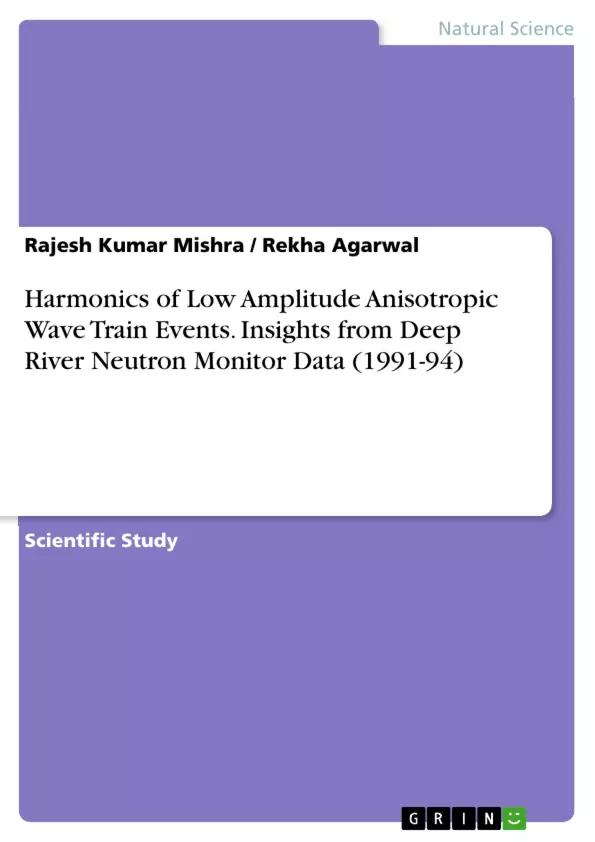This study investigates the phenomenon of Low Amplitude Anisotropic Wave Train Events (LAWEs) in cosmic ray intensity using data from the ground-based Deep River neutron monitor for the period 1991-94. The analysis reveals that the amplitude of diurnal anisotropy during LAWE events consistently remains low and statistically constant compared to the quiet day annual average amplitude for the majority of events. Furthermore, the timing of the maximum diurnal anisotropy for LAWE events shifts significantly towards earlier hours, aligning with the co-rotational direction and remaining consistent with the direction of quiet day annual average anisotropy for most events.
Conversely, the amplitude of semi/tri-diurnal anisotropy remains statistically high and unchanged. However, the phase shift occurs towards later hours compared to the quiet day annual average values for the majority of LAWEs. Analysis of diurnal anisotropy vectors reveals a shift towards earlier hours in 50% of events and a shift towards later hours in the remaining 50%, relative to the average vector for the entire period. Additionally, it is observed that the amplitude of these vectors significantly increases with the shift towards later hours.
The study suggests that high-speed solar wind streams do not play a significant role in causing LAWE events on a short-term basis, but they may contribute to these events on a long-term basis. The occurrence of LAWE is found to be dominant when the polarity of Bx and Bz remains positive, and the polarity of By remains negative — a phenomenon not reported previously. Furthermore, the amplitude of the first harmonic exhibits a good anti-correlation with solar wind velocity, while the direction of the first and third harmonics shows nearly good anti-correlation. The direction of the second harmonic shows nearly good anti-correlation with interplanetary magnetic field strength.
Inhaltsverzeichnis (Table of Contents)
- Abstract
- Keywords
- Introduction
- Data Sources and Analysis
- Trend Correction
- Results and discussion
Zielsetzung und Themenschwerpunkte (Objectives and Key Themes)
This research focuses on investigating the occurrence and characteristics of unusually low amplitude anisotropic wave train events (LAWEs) in cosmic ray intensity, specifically those observed between 1991 and 1994. Using data from the Deep River neutron monitor, the study aims to analyze the behavior of amplitude and phase of the diurnal, semi-diurnal, and tri-diurnal anisotropies during these events. The research further investigates the relationship between LAWE and interplanetary parameters like the interplanetary magnetic field (IMF) and solar wind plasma (SWP).
- The unusual nature of low-amplitude anisotropic wave train events (LAWEs) in cosmic ray intensity
- The behavior of amplitude and phase of the diurnal, semi-diurnal, and tri-diurnal anisotropies during LAWE
- The correlation between LAWE and interplanetary parameters (IMF, SWP)
- The physical mechanisms responsible for the occurrence of LAWE
- The specific interplanetary configurations associated with LAWE
Zusammenfassung der Kapitel (Chapter Summaries)
- Abstract: Introduces the study of low amplitude anisotropic wave train events (LAWEs) in cosmic ray intensity during 1991-94 using Deep River neutron monitor data. Highlights the anomalous behavior of diurnal and semi/tri-diurnal anisotropy during these events.
- Introduction: Discusses the origin and nature of daily variation in cosmic ray intensity, emphasizing the role of spatial anisotropies in interplanetary space. Reviews previous studies on diurnal, semi-diurnal, and tri-diurnal variations in cosmic ray intensity, highlighting the importance of understanding deviations from average values.
- Data Sources and Analysis: Describes the data source, Deep River neutron monitor data, and the methodology used to identify and analyze LAWEs. Outlines the steps involved in data correction, including barometer, geomagnetic bending, and orbital Compton-Getting effects. Explains the trend correction method employed to analyze the data.
Schlüsselwörter (Keywords)
The primary keywords and focus topics of the research include cosmic rays, diurnal, semi-diurnal, anisotropy, solar wind, interplanetary magnetic field, low-amplitude anisotropic wave train events (LAWEs), and Deep River neutron monitor.
- Quote paper
- Rajesh Kumar Mishra (Author), Rekha Agarwal (Author), 2024, Harmonics of Low Amplitude Anisotropic Wave Train Events. Insights from Deep River Neutron Monitor Data (1991-94), Munich, GRIN Verlag, https://www.grin.com/document/1437594



